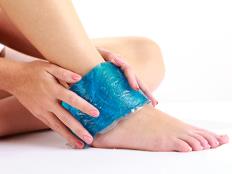How to Treat the Injury
Once the you've identified what cause the injury, you can devise a treatment plan.. Rest is usually the first step in eliminating the issue. "Back off training and don't progress forward until pain and symptoms subside," says Johnson. "Be smart and listen to your body—inflamed tissue won't be as responsive and most likely will become more irritated with persistent pounding."
Massage and other related treatments like Active Release Techniques and Graston can help work out adhesions and bring blood flow to the area. Be sure to consult an expert, however, and avoid irritating the problem by trying to do self-massage.
Try to apply ice for a few minutes several times a day. Get in the habit of icing after activity, especially if you are doing any cross training.
Start With Prevention
Prevention is preferable to treatment. "Don't wait to get help," Johnson says. "I see so many patients who wait until they are unable to run to come in for treatment."
Since physical therapists are well versed in preventative care, if you feel a twinge, it's worth seeking advice.
Smart training and proper footwear can be particularly effective at preventing Achilles problems. Increase your training mileage by no more than 10 percent each week and be sure to take rest days or easy runs after high intensity workouts.
More: When to Replace Running Shoes
If your body is resisting a workout, back off and try it the next day. It's not worth benching yourself for weeks with an injury to force through one session.
A Stretch a Day Will Keep the Doctor Away
Use a foam roller or other massage tools to keep your muscles flexible and pliable. Regular maintenance takes just a few minutes each day and ward off injuries. Regular strength work can also help fortify the stabilizer muscles in your lower legs to support your stride and avoid overcompensation-related Achilles injuries.
You can eliminate many of the factors that can lead to Achilles injuries by wearing proper fitted running shoes, sticking to a smart training program that includes proper mileage and completing regular flexibility and strength work. Since prevention is always better than weeks and months spent trying to tame an injury, always be sure to listen to your body and know when it's time to take a day off or cut a run short. To be sure, these measures will prevent you from running yourself into all kinds of injuries.
More: How to Treat and Prevent Injuries: Iliotibial Band Syndrome
 Sign up for your next race.
Sign up for your next race.- 2
- of
- 2
About the Author

Get ACTIVE on the Go


Couch to 5K®
The best way to get new runners off the couch and across the finish line of their first 5K.
Available for iOS | Android







Discuss This Article